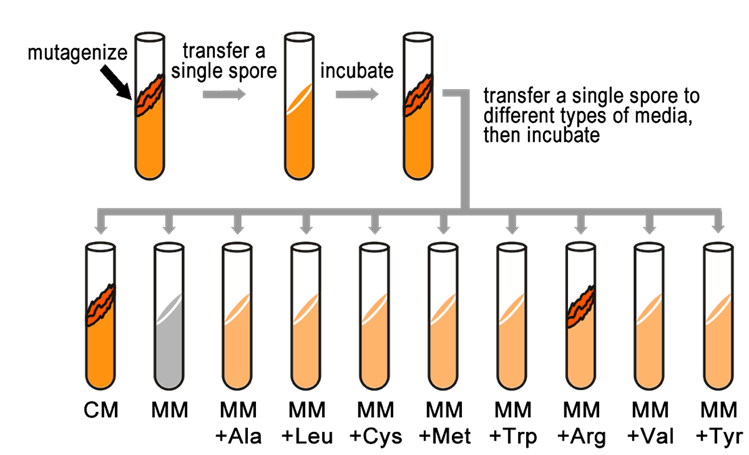7.2 The Beadle and Tatum Experiments
In 1941, over 30 years after Garrod’s discovery, Beadle and Tatum built on this connection between genes and metabolic pathways. Their research led to the “one gene, one enzyme (or protein)” hypothesis, which states that each enzyme that acts in a biochemical pathway is encoded by a different gene. Although we now know of many exceptions to the “one gene, one enzyme” principle, it is generally true that each gene produces a protein with a distinct catalytic, regulatory, or structural function.
Beadle and Tatum used the fungus Neurospora crassa (a bread mould) for their studies, because it had practical advantages as a laboratory model organism. They knew that Neurospora was prototrophic, meaning it could grow on minimal medium (MM). Minimal medium lacked most nutrients, except for a few minerals, simple sugars, and one vitamin (biotin). Prototrophs can synthesize the amino acids, vitamins, etc. necessary for normal growth.
They isolated a series of mutations known to interrupt the synthesis of arginine, an amino-acid necessary for mould growth. Their hypothesis stated that individual mutations inhibited discrete steps in the pathway used by the mould to synthesize arginine from precursors in their environmental medium.
The video below, Beadle and Tatum Part 1: Neurospora crassa, by SciencePrimer (2018) on YouTube, gives an introduction to haploid Neurospora crassa which Beadle and Tatum used in their experiments.
Note: You can watch Beadle and Tatum Part 2: The Experiment, by SciencePrimer (2018) on YouTube (https://youtu.be/fXASTY-YoRQ).
They knew that by exposing Neurospora spores to X-rays, they could randomly induce mutations in genes (now known as damage to the DNA leading to DNA sequence change). Each spore exposed to X-rays potentially contained a mutation in a different gene. While most mutagenized spores were still able to grow (prototrophic), some spores had mutations that changed their phenotype from a prototroph into an auxotrophic strain, which could no longer grow on minimal medium. Instead these auxotrophs could grow on complete medium (CM), which was MM supplemented with nutrients, such as amino acids and vitamins, etc. (Figure 7.2.1). In fact, some auxotrophic mutations could grow on minimal medium with only one, single nutrient supplied, such as the amino acid arginine. This implied that each auxotrophic mutant was blocked at a specific step in a biochemical pathway and that by adding an essential compound, such as arginine, that block could be circumvented. Figure 7.2.2 gives the results of such experiments, demonstrating the survival (or not) of mutants, depending on the nutrients supplied, and the perturbation of the biochemical pathway involved, depending on the particular mutation.


Beadle and Tatum linked many nutritional mutants to specific amino acids and vitamin biochemical pathways. This work demonstrated that individual genes are connected to specific enzymes. This initial discovery which made the link between genes and enzymes (which garnered a Nobel prize) was called the “one gene-one enzyme” hypothesis, which we will look at in the next section.
Media Attributions
- Figure 7.2.1 Original by Deyholos (2017), CC BY-NC 3.0, Open Genetics Lectures
- Figure 7.2.2 OSC Microbio 10 01 GeneEnzyme from Parker et al. (2016), CNX OpenStax, CC BY 4.0, via Wikimedia Commons
References
Deyholos, M. (2017). Figure 3. A single mutagenized spore…[digital image]. In Locke, J., Harrington, M., Canham, L. and Min Ku Kang (Eds.), Open Genetics Lectures, Fall 2017 (Chapter 3, p. 2). Dataverse/ BCcampus. http://solr.bccampus.ca:8001/bcc/file/7a7b00f9-fb56-4c49-81a9-cfa3ad80e6d8/1/OpenGeneticsLectures_Fall2017.pdf
Parker, N., Schneegurt, M., Thi Tu, A-H., Lister, P., Forster, B. M. (2016, November 1). Figure 10.6 Three classes of arginine mutants were identified…[digital image]. In Microbiology. OpenStax. https://openstax.org/books/microbiology/pages/10-1-using-microbiology-to-discover-the-secrets-of-life
SciencePrimer. (2018, December 18). Beadle and Tatum Part 1: Neurospora crassa (video file). YouTube. https://www.youtube.com/watch?v=cETqxjsB_Bw
SciencePrimer. (2018, December 22). Beadle and Tatum Part 2: The Experiment (video file). YouTube. https://www.youtube.com/watch?v=fXASTY-YoRQ
Long Descriptions
- Figure 7.2.1 A single mutagenized spore is used to establish a colony of genetically identical fungi, from which spores are tested for their ability to grow on different types of media. Because spores of this particular colony can only grow on complete medium (CM), or on minimal medium supplemented with arginine (MM+Arg), they are considered Arg auxotrophs, and we infer that they have a mutation in a gene in the Arg biosynthetic pathway. This type of screen is repeated many times to identify other mutants in the Arg pathway and in other pathways. [Back to Figure 7.2.1]
- Figure 7.2.2 Beadle and Tatum experimental set up which shows the wild type alongside various mutants and their ability to grow or not on either minimal media or minimal media supplemented with various nutrients such as ornithine, citrulline and arginine. Depending on whether the mutant grew or not, biochemical pathways are postulated, whereby the mutant lacks a specific enzyme, which is part of the series required to convert a precursor into arginine, which is the final product of the pathway. [Back to Figure 7.2.2]

